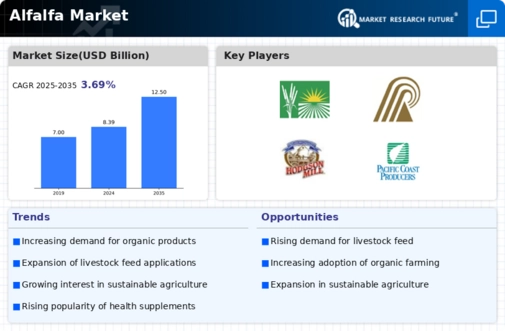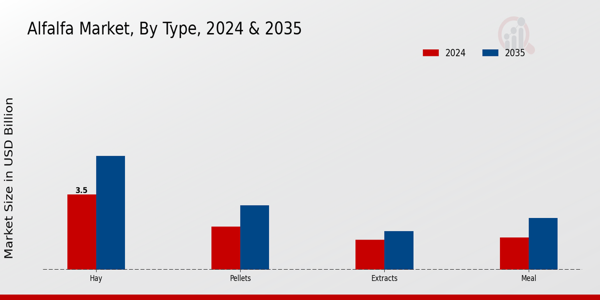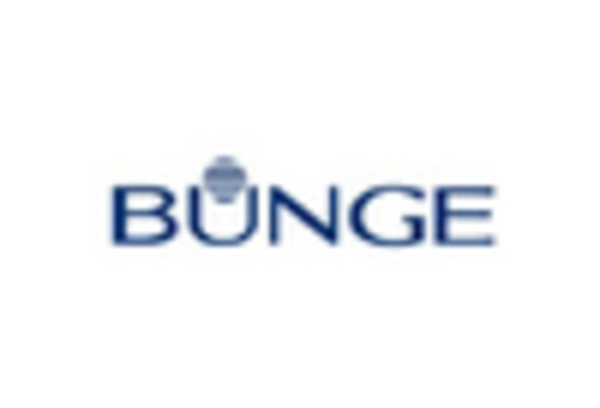Health Benefits of Alfalfa
The Alfalfa Market is also benefiting from the increasing awareness of the health benefits associated with alfalfa consumption. Alfalfa is rich in vitamins, minerals, and antioxidants, making it a valuable addition to human diets. The growing trend towards plant-based diets has led to a rise in the consumption of alfalfa in various forms, including supplements and health foods. Research suggests that alfalfa may help in lowering cholesterol levels and improving digestion, which resonates with health-conscious consumers. As the demand for nutritious and functional foods continues to rise, the alfalfa market is likely to expand, catering to both the livestock and human consumption sectors.
Rising Demand for Animal Feed
The Alfalfa Market is experiencing a surge in demand for high-quality animal feed, particularly in the livestock sector. Alfalfa is recognized for its high protein content and digestibility, making it a preferred choice for dairy and beef cattle. Recent statistics indicate that alfalfa hay production reached approximately 60 million tons in the last year, reflecting a growing trend among livestock producers to incorporate alfalfa into their feeding regimens. This rising demand is further fueled by the increasing global population and the corresponding need for protein-rich food sources. As livestock producers seek to enhance the nutritional value of their feed, the alfalfa market is poised for continued growth, driven by this escalating demand.
Government Support and Subsidies
Government policies and subsidies play a crucial role in shaping the Alfalfa Market. Many governments are implementing programs to support farmers in the cultivation of alfalfa, recognizing its benefits for soil health and livestock nutrition. These initiatives often include financial assistance, research funding, and educational resources aimed at promoting sustainable farming practices. For instance, certain regions have introduced subsidies for alfalfa production, which can significantly reduce the financial burden on farmers. This support not only encourages the cultivation of alfalfa but also enhances its marketability. As government backing continues, the alfalfa market is expected to thrive, fostering a more robust agricultural sector.
Sustainable Agricultural Practices
The Alfalfa Market is increasingly influenced by the adoption of sustainable agricultural practices. Farmers are recognizing the importance of environmentally friendly methods, which not only enhance soil health but also improve crop yields. The integration of alfalfa into crop rotation systems is gaining traction, as it enriches the soil with nitrogen, reducing the need for synthetic fertilizers. This practice aligns with the growing consumer demand for sustainably sourced products. Furthermore, the alfalfa market is projected to grow at a compound annual growth rate of approximately 4.5% over the next five years, driven by these sustainable practices. As more farmers transition to organic and sustainable methods, the alfalfa market is likely to see a significant increase in both production and consumption.
Technological Innovations in Farming
Technological advancements are reshaping the Alfalfa Market, leading to enhanced productivity and efficiency. Precision agriculture technologies, such as GPS-guided equipment and soil moisture sensors, are being adopted to optimize alfalfa cultivation. These innovations allow farmers to monitor crop health in real-time, ensuring optimal irrigation and nutrient application. The use of drones for crop surveillance is also becoming prevalent, enabling farmers to identify issues early and take corrective actions. According to recent data, the implementation of these technologies can increase alfalfa yields by up to 20%. As technology continues to evolve, the alfalfa market is expected to benefit from increased efficiency and reduced operational costs, making it a more attractive option for farmers.


















Leave a Comment